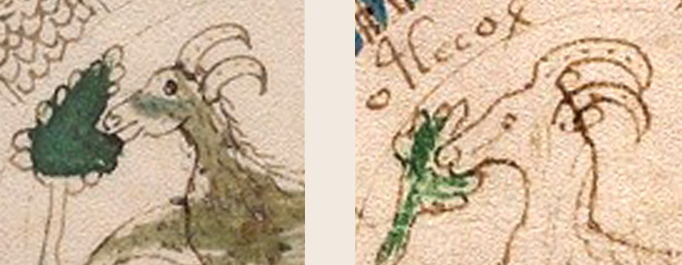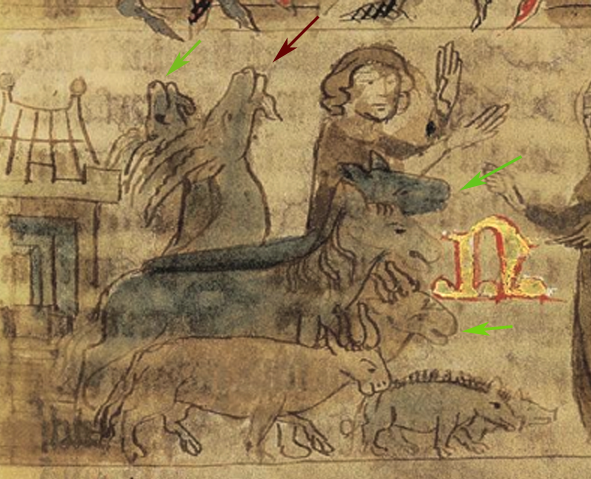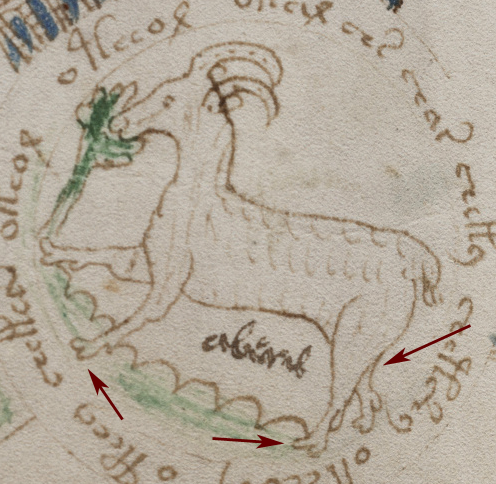In March 2016, I posted details of the noses of the green and white rams in the Voynich Manuscript, to point out that they were drawn by different people (I am quite sure of this). The first is a more confident hand with a better sense of anatomy, the second is drawn with less dexterity and the person who drew it was less aware of the structure of the bones underneath the form.
There are other parts of the manuscript with slight differences in drawing styles, and there appear to be at least two painters and at least two scribes, so perhaps it’s not surprising that there might be more than one illustrator as well.
Quite unexpectedly, when looking at commonalities between some of the drawings in a Welsh book of law, and the Picatrix, I came across something in one of the illustrated versions of the Sachsenspiegel (The Saxon Mirror, a book of Saxon law) that reminded me of the VMS. It took me by surprise because the two different drawing styles are evident in rams and goats and makes one wonder whether the VMS rams might represent goats (we only assume from their position relative to the other roundels that they are probably rams, the drawings are not expert enough to know for sure).
Two Pairs of Noses
The Sachsenspiegel illustration includes human figures, a building, and various herd animals in pairs. If you look closely at the two goats with their heads raised, you will notice the one in front has a nose and neck that is more deftly and confidently drawn (marked with a red arrow). Note how the upper lip is more clearly modeled with a better sense of line and the underlying anatomy. In contrast, the other animals have rounded indistinct features with a much weaker sense of the structure under the skin. I instantly had the feeling of a teacher/apprentice or parent/child relationship. The teacher (or team leader) draws in some of the key points, to give an idea of what is desired and where things go, and the apprentice fills in the rest.
Could the Sachsenspiegel have been drawn by the same illustrators who created the VMS?
The more accomplished hand in the VMS is similar to the drawing style of the more accomplished hand in the Sachsenspiegel and the less accomplished is quite similar, as well, but it seems unlikely that they had any involvement in the VMS. Both the more and less accomplished hands in the Sachsenspiegel show stylistic differences from the two hands in the VMS. Note especially that the hind legs of the animals in the Sachsenspiegel point in the anatomically correct direction and the hooves look more or less like hooves.
In contrast, in the VMS, the hind legs of most of the animals are anatomically strange, with the middle joint almost nonexistent. The VMS hooves are also unusually round and include prominent dewlaps. These characteristics, especially the missing joint, are very difficult to find in other medieval drawings and are not characteristic of either hand in the Sachsenspiegel.
So, the drawing styles in the Sachsenspiegel and the VMS do not match, but perhaps they are similar in the sense of a mentor-student relationship.
If I had to guess, I would say that the more skilled illustrator drew many of the human figures and perhaps some of the buildings in the Sachsenspiegel—in other words, a substantial portion of the drawings. In the VMS, I get the opposite feeling… that most of it was drawn by the less expert illustrator, with only a few possible additions by someone with more skill (and perhaps some later additions by a third person with even less skill).
Summary
I keep hoping I’ll find other drawings by whoever drew the VMS, but haven’t been lucky so far, but maybe the Sachsenspiegel goats can explain the dots on the horns of the VMS animals.
In the Sachsenspiegel, the goats have bumps on the horns like the Ibex, a form of mountain goat. On the VMS, there is a series of dots that might indicate the more shallow ridges on the horns of most other species of goats and rams.
I’m not 100% certain the VMS white and green rams are actually sheep/rams, I never have been. I’ve always wondered why there are two, which is not typical of a zodiac sequence. It occurred to me that the white one might be Capricorn and the green one Aries, for example, but their position in sequence with the others seems to argue against this. I do have one idea as to why they might be out of sequence, however, which I’ll blog about as soon as I have time.
J.K. Petersen
© Copyright 2017 J.K. Petersen, All Rights Reserved



